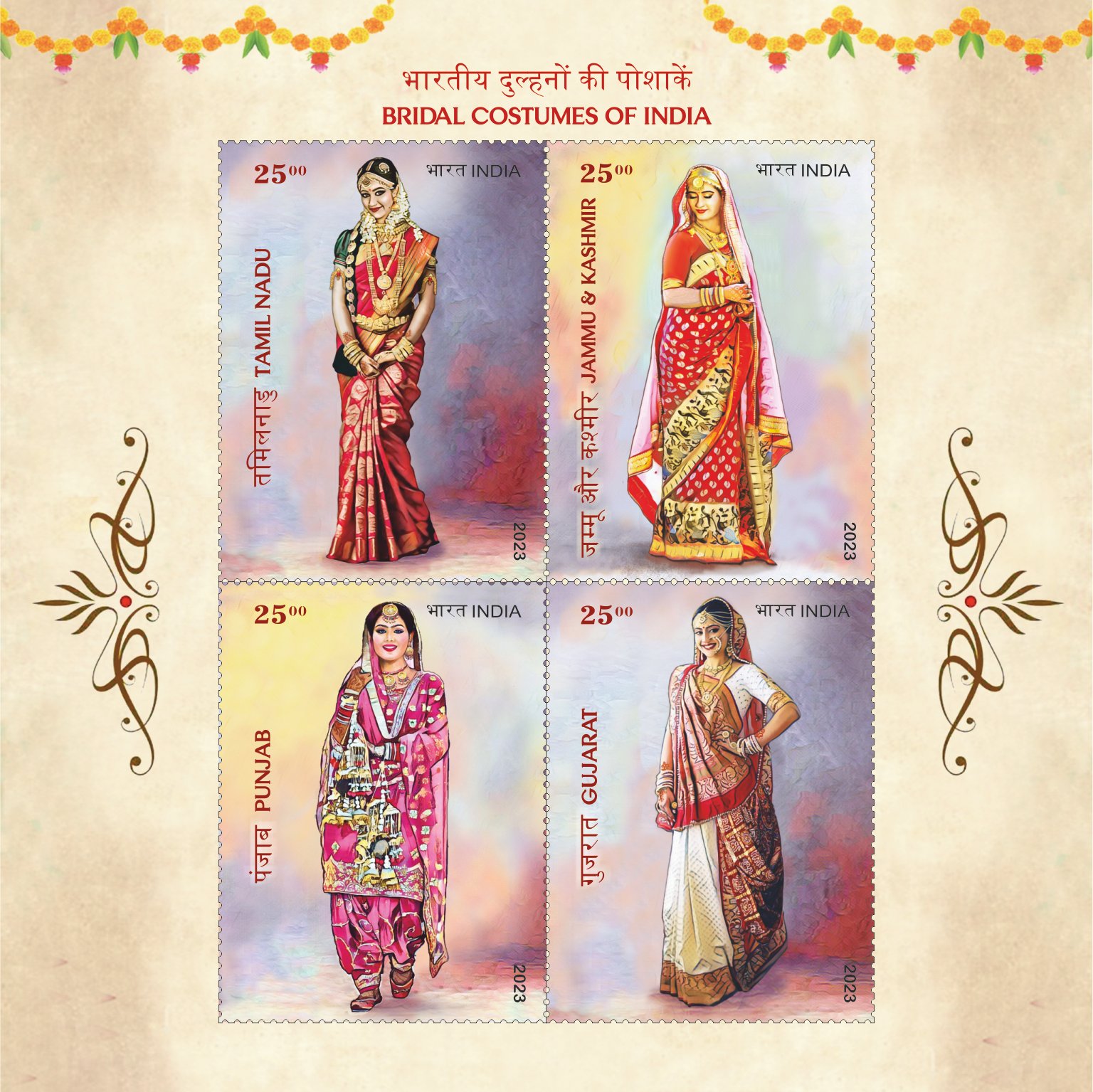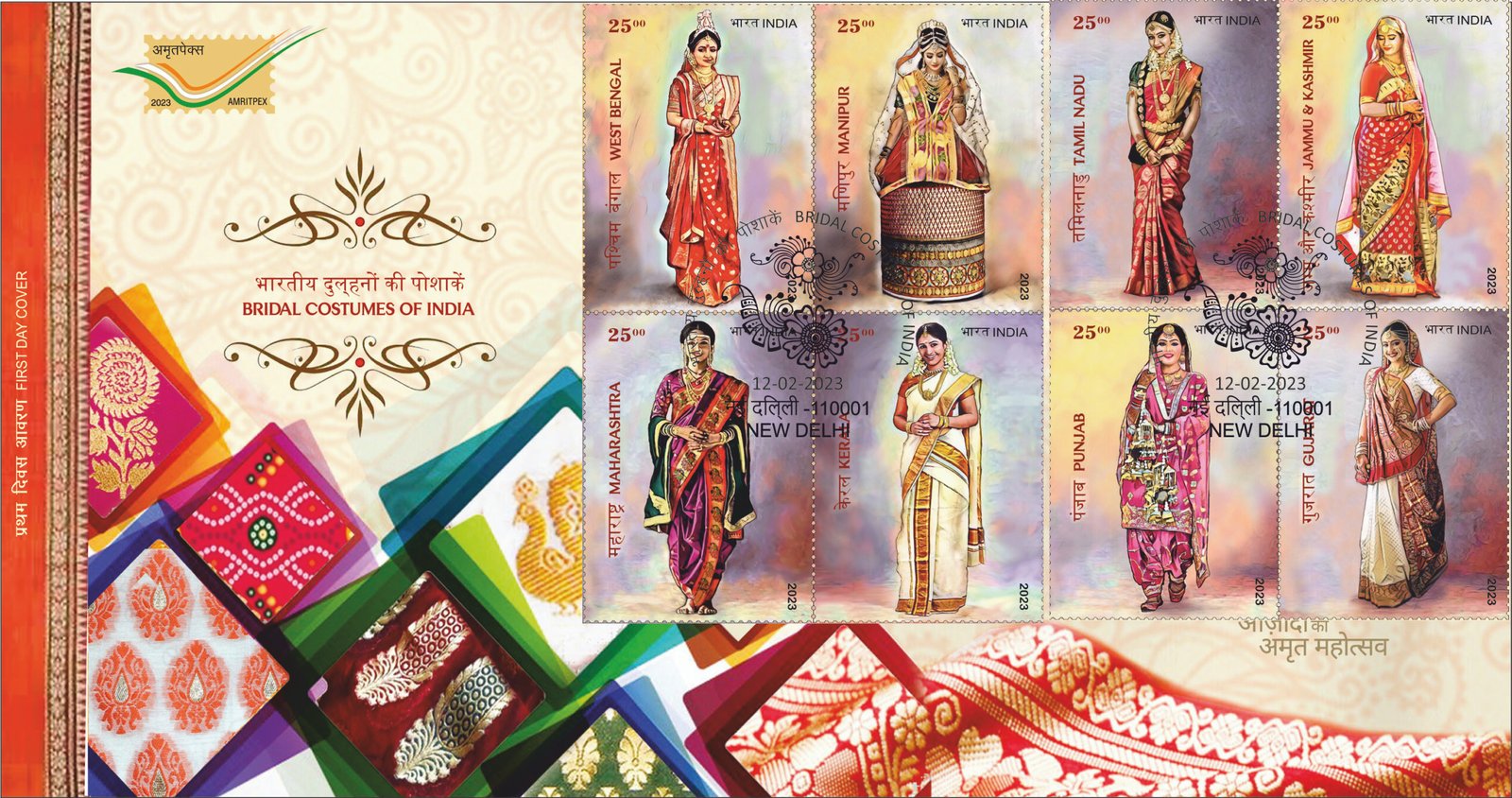Bridal Costumes of India

Technical Data
| Stamp Set | Brides in Traditional Costumes |
|---|---|
| Date of Issue | February 12, 2023 |
| Denomination | Rs. 100 |
| Quantity | 111,000 |
| Perforation | 14½ |
| Printer | Security Printing Press, Hyderabad |
| Printing Process | Wet Offset |
| Watermark | No Watermark |
| Colors | Multicolor |
| Credit (Designed By) | Ms. Gulistaan Ms. Nenu Gupta |
| Catalog Codes |
Yvert et Tellier IN BF224 Michel IN BL240 Stanley Gibbons IN MS3841 Colnect codes IN 2023.02.12-02 |
| Themes | Suits and Costumes |
Bridal Costumes of India – A Celebration on Stamps
Weddings and Indian Culture
Weddings in India are not merely ceremonies but grand cultural celebrations. They reflect traditions, rituals, food habits, clothing, and the lifestyle of communities across the country. A wedding is a collective festivity where family, friends, and well-wishers gather to bless the bride and groom as they embark on their new journey together.
The Symbolism of Red in Indian Weddings
Red is the most predominant bridal color in India. It signifies new beginnings, prosperity, passion, and strength. The color is also associated with Goddess Durga, symbolizing feminine power. Since the bride transitions into a new phase of life and home, red reflects her central role in commanding attention and marking new beginnings.
Regional Diversity in Bridal Costumes
South India
Tamilian brides dignify their wedding look with Kanchipuram Saree or Madurai Silk. A typical tamil bride usually wears a Kanjeevaram Saree in hues of bright colors with contrasting borders that have gold threads woven into beautiful patterns. Tamil bride is adorned with gorgeous looking heavy gold jewelry, passed on from one generation to the next. A few prominent jewelry pieces that adorn a Tamil bride are Metti (Toe Ring), Kolusu (Anklet), Oddiyanam (HipBelt), Vanki (Armlets), Maanga Malai (Mango shaped necklace), Nose Ring or Nose Stud, Earrings, Thalaisamaan (on forehead), Jadanagam (decorated braid). No tamil marriage is complete without wearing the flowers on the women’s head.
North India
The Punjabi Brides wear a Salwar Kameez, an extremely opulent pant suit, or lengha. The bride wears white and dark red bangles made of ivory known as ‘Chooda’. They are usually in multiples of four and according to tradition the bride must wear it for at least a year after her marriage. Chooda and Kaleeras are the real essentials of a Punjabi bride’s wedding day look.
The Kashmiri bride complement her looks with weaved saress which are remarkably jazzy due its adorned work. The bride completes her wedding look with Tarang, Kalpush, Zoojhis and matching dupatta. Their jewelry consists of heavy necklaces, bangles, payals and special ornament called Dejharoo, akin to a Mangalsutra in Indian culture.
Western India
The Gujarati bridal saree is called as a Panetar. Gujarati brides prefer to wear the traditional cream/ white and red saree for the wedding rituals. Many brides also choose Panetar style wedding lehenga choli that is made in white/ cream and red colors. Kundan necklace, heavy Jadau earrings or Jhumkas, also known as ‘kan ni butti’ in Gujarati, rings, Nathani or nose ring, armlets, hand ornaments, anklets, bangles, hair ornaments and Maang tikka or the forehead jewelry comprising of the entire array of jewels the bride adorns herself with. Gujrati Brides also wear fine Bandhani sarees during their wedding ceremonies. One such glorious Bandhani saree is called as Gharchola – which is traditionally made in the colors of red/ maroon and green with Bandhani work and metallic and thread embroidery.
Stamps Celebrating Bridal Costumes
The Department of Posts proudly celebrates this cultural richness through the issue of two sets of Souvenir Sheets with commemorative postage stamps on “Bridal Costumes of India.” These stamps showcase the diversity of Indian bridal attire, capturing the vibrant colors, unique traditions, and regional artistry that make Indian weddings unforgettable.
For philatelists, this collection is not just a tribute to the beauty of Indian weddings but also a reminder of how deeply woven traditions are into the fabric of society. Each stamp is a miniature canvas of India’s cultural heritage, honoring the spirit of unity in diversity.
First Day Cover

